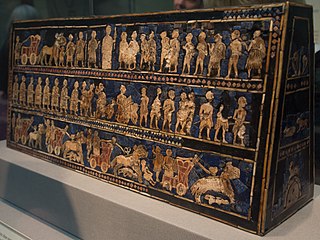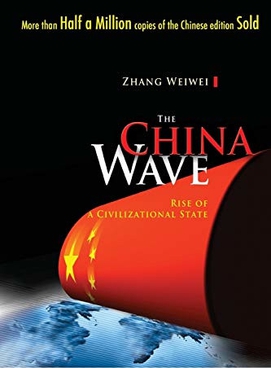
Asia is the largest continent in the world by both land area and population. It covers an area of more than 44 million square kilometers, about 30% of Earth's total land area and 8% of Earth's total surface area. The continent, which has long been home to the majority of the human population, was the site of many of the first civilizations. Its 4.7 billion people constitute roughly 60% of the world's population.

Hindus are people who religiously adhere to Hinduism. Historically, the term has also been used as a geographical, cultural, and later religious identifier for people living in the Indian subcontinent.

The Malay Peninsula is a peninsula in Mainland Southeast Asia. The landmass runs approximately north–south, and at its terminus, it is the southernmost point of the Asian continental mainland. The area contains Peninsular Malaysia, Southern Thailand, and the southernmost tip of Myanmar (Kawthaung). The island country of Singapore also has historical and cultural ties with the region. The indigenous people of the peninsula are Orang Asli and Malays, an Austronesian people.

The Indus Valley Civilisation (IVC), also known as the Indus Civilisation, was a Bronze Age civilisation in the northwestern regions of South Asia, lasting from 3300 BCE to 1300 BCE, and in its mature form 2600 BCE to 1900 BCE. Together with ancient Egypt and Mesopotamia, it was one of three early civilisations of the Near East and South Asia, and of the three, the most widespread, its sites spanning an area from much of Pakistan, to northeast Afghanistan, and northwestern India. The civilisation flourished both in the alluvial plain of the Indus River, which flows through the length of Pakistan, and along a system of perennial monsoon-fed rivers that once coursed in the vicinity of the Ghaggar-Hakra, a seasonal river in northwest India and eastern Pakistan.

The "Clash of Civilizations" is a thesis that people's cultural and religious identities will be the primary source of conflict in the post–Cold War world. The American political scientist Samuel P. Huntington argued that future wars would be fought not between countries, but between cultures. It was proposed in a 1992 lecture at the American Enterprise Institute, which was then developed in a 1993 Foreign Affairs article titled "The Clash of Civilizations?", in response to his former student Francis Fukuyama's 1992 book The End of History and the Last Man. Huntington later expanded his thesis in a 1996 book The Clash of Civilizations and the Remaking of World Order.

Ancient history is a time period from the beginning of writing and recorded human history through late antiquity. The span of recorded history is roughly 5,000 years, beginning with the development of Sumerian cuneiform script and continuing until the expansion of Islam in late antiquity. Ancient history covers all continents inhabited by humans in the period 3000 BC – AD 750. The three-age system periodizes ancient history into the Stone Age, the Bronze Age, and the Iron Age, with recorded history generally considered to begin with the Bronze Age. The start and end of the three ages vary between world regions. In many regions the Bronze Age is generally considered to begin a few centuries prior to 3000 BC, while the end of the Iron Age varies from the early first millennium BC in some regions to the late first millennium AD in others.
Hindutva is a political ideology encompassing the cultural justification of Hindu nationalism and the belief in establishing Hindu hegemony within India. The political ideology was formulated by Vinayak Damodar Savarkar in 1922. It is used by the Rashtriya Swayamsevak Sangh (RSS), the Vishva Hindu Parishad (VHP), the Bharatiya Janata Party (BJP) and other organisations, collectively called the Sangh Parivar.

A cradle of civilization is a location and a culture where civilization was developed independent of other civilizations in other locations. The formation of urban settlements (cities) is the primary characteristic of a society that can be characterized as "civilized". Other characteristics of civilization include a sedentary non-nomadic population, monumental architecture, the existence of social classes and inequality, and the creation of a writing system for communication. The transition from simpler societies to the complex society of a civilization is gradual.

Ancient Judaism is an essay written by the German economist and sociologist Max Weber in the early 20th century. The original edition appeared in the 1917–1919 issues of the Archiv für Sozialwissenschaft und Sozialpolitik. Marianne Weber, his wife, published the essays as Part Three of his Gesammelte Aufsatze zur Religionssoziologie in 1920–1921. An English translation was made in 1952 and several editions were released since then.

The culture of Asia encompasses the collective and diverse customs and traditions of art, architecture, music, literature, lifestyle, philosophy, food, politics and religion that have been practiced and maintained by the numerous ethnic groups of the continent of Asia since prehistory. Identification of a specific culture of Asia or universal elements among the colossal diversity that has emanated from multiple cultural spheres and three of the four ancient River valley civilizations is complicated. However, the continent is commonly divided into six geographic sub-regions, that are characterized by perceivable commonalities, like culture, religion, language and relative ethnic homogeneity. These regions are Central Asia, East Asia, North Asia, South Asia, Southeast Asia and West Asia.

Greater India, also known as the Indian cultural sphere, or the Indic world, is an area composed of many countries and regions in South, East Asia and Southeast Asia that were historically influenced by Indian culture, which itself formed from the various distinct indigenous cultures of these regions. The term Greater India, as a reference to the Indian cultural sphere, was popularised by a network of Bengali scholars in the 1920s. It is an umbrella term encompassing the Indian subcontinent and surrounding countries, which are culturally linked through a diverse cultural cline. These countries have been transformed to varying degrees by the acceptance and introduction of cultural and institutional elements from each other. Since around 500 BCE, Asia's expanding land and maritime trade had resulted in prolonged socio-economic and cultural stimulation and diffusion of Buddhist and Hindu beliefs into the region's cosmology, in particular in Southeast Asia and Sri Lanka. In Central Asia, the transmission of ideas was predominantly of a religious nature.

Societal collapse is the fall of a complex human society characterized by the loss of cultural identity and of social complexity as an adaptive system, the downfall of government, and the rise of violence. Possible causes of a societal collapse include natural catastrophe, war, pestilence, famine, economic collapse, population decline or overshoot, mass migration, and sabotage by rival civilizations. A collapsed society may revert to a more primitive state, be absorbed into a stronger society, or completely disappear.
Meta-ethnicity is a relatively recent term occasionally used in academic literature or public discourse on ethnic studies. It describes a level of commonality that is wider ("meta-") and more general than ethnicity, but does not necessarily correspond to nation or nationality. In colloquial discourse, it usually signifies a larger in-group of distinct ethnic groups who identify more closely with each other than they would with out-group ethnic groups. The groups within the in-group may be genetically and culturally related which reinforces the grouping.

Imperial China: 900–1800 is a history book written by Frederick W. Mote, Professor of Chinese History and Civilization, Emeritus, at Princeton University. The book was published in 1999 by Harvard University Press.

Science and Civilisation in China (1954–present) is an ongoing series of books about the history of science and technology in China published by Cambridge University Press. It was initiated and edited by British historian Joseph Needham (1900–1995). Needham was a well-respected scientist before undertaking this encyclopedia and was even responsible for the "S" in UNESCO. To date there have been seven volumes in twenty-seven books. The series was on the Modern Library Board's 100 Best Nonfiction books of the 20th century. Needham's work was the first of its kind to praise Chinese scientific contributions and provide their history and connection to global knowledge in contrast to eurocentric historiography.

East Asia is a region of Asia, which is defined in both geographical and ethno-cultural terms. The modern states of East Asia include China, Japan, Mongolia, North Korea, South Korea, and Taiwan. Hong Kong and Macau, two coastal cities located in the south of China, are autonomous regions under Chinese sovereignty. The economies of Japan, South Korea, China, Taiwan, Hong Kong, and Macau are some of the world's largest and most prosperous economies. East Asia borders Siberia and the Russian Far East to the north, Southeast Asia to the south, South Asia to the southwest, and Central Asia to the west. To the east is the Pacific Ocean and to the southeast is Micronesia.

Zhang Weiwei is a Chinese professor of international relations at Fudan University and the director of its China Institute. Zhang is also an Internet celebrity, spreading his political ideas through online video platforms such as Xigua Video, Bilibili, TikTok and YouTube.

The China Wave: Rise of a Civilizational State is a 2011 book by Zhang Weiwei about China's economic and geopolitical rise to the status as an emerging global power. It was originally published in Chinese with the English language version being published in 2012. In the book Zhang argues that China's rapid economic development proves the success of China's model of governance and exceptionalism. Zhang argues that China is unique and exceptional because it is a civilization state. A concept that Zhang outlines in the book and that he feels challenges Western assumptions about human rights, good governance, and democracy.
Chinese exceptionalism is the belief that China is either distinctive, unique, or exemplary compared to other nations. Clarissa Tan described Zhang Weiwei and Eric X. Li as Chinese exceptionalists who argue that the China model is the right path for China, a civilization state. According to Tan, this view has become increasingly popular. The Chinese government has recruited Chinese exceptionalism into its notion of a "peaceful rise." According to John M. Friend and Bradley A. Thayer, within Han nationalist narrative, Han culture is considered to be the authentic character of the Chinese nation; to deviate from the Han identity will only tarnish Chinese exceptionalism and impede China’s rise.















